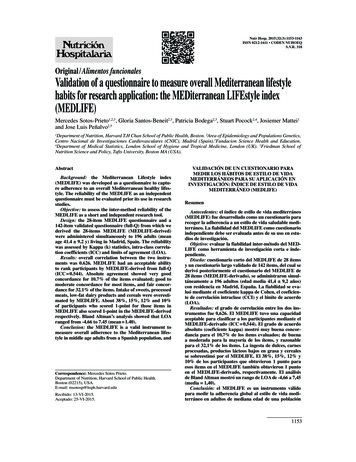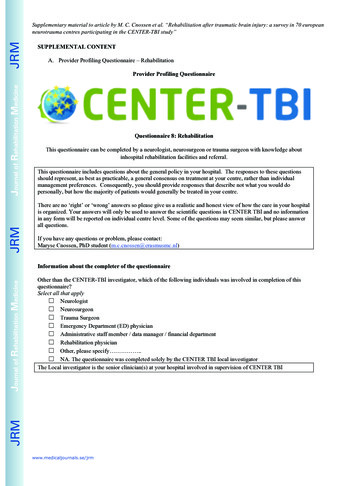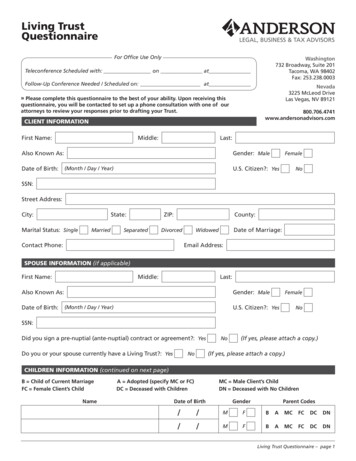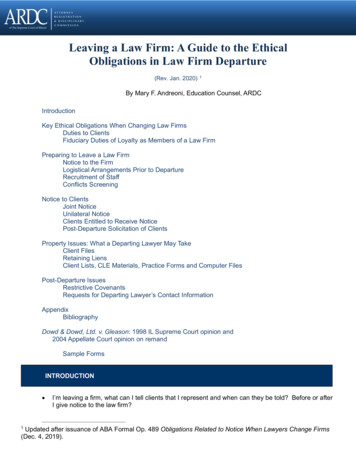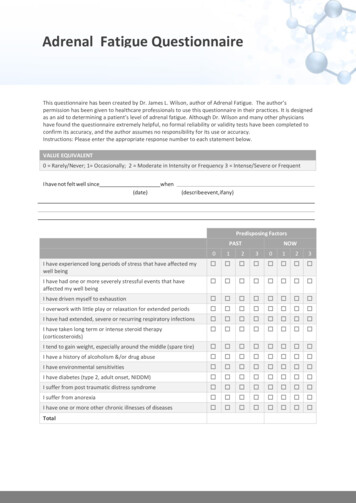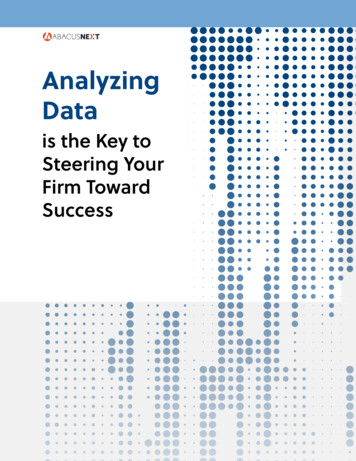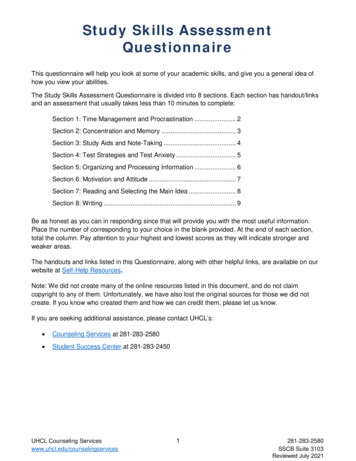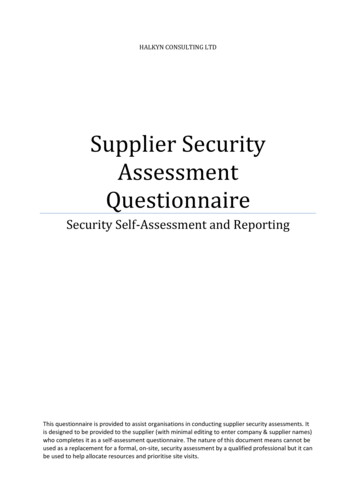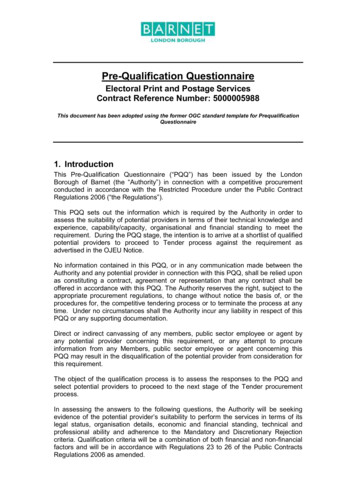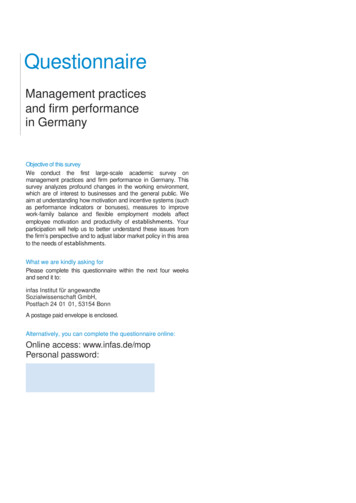
Transcription
QuestionnaireManagement practicesand firm performancein GermanyObjective of this surveyWe conduct the first large-scale academic survey onmanagement practices and firm performance in Germany. Thissurvey analyzes profound changes in the working environment,which are of interest to businesses and the general public. Weaim at understanding how motivation and incentive systems (suchas performance indicators or bonuses), measures to improvework-family balance and flexible employment models affectemployee motivation and productivity of establishments. Yourparticipation will help us to better understand these issues fromthe firm’s perspective and to adjust labor market policy in this areato the needs of establishments.What we are kindly asking forPlease complete this questionnaire within the next four weeksand send it to:infas Institut für angewandteSozialwissenschaft GmbH,Postfach 24 01 01, 53154 BonnA postage paid envelope is enclosed.Alternatively, you can complete the questionnaire online:Online access: www.infas.de/mopPersonal password:persönliches Kennwort:
QuestionnaireManagement practicesand firm performancein GermanyWhat happens with your dataThe institutes conducting this survey are jointlyresponsible for ensuring data protection. All ofyour information is treated strictly confidential,following German data protection legislation.This means: The research institutes (IfW, IAB)receive your data without information on the nameor address of your establishment, supplementedby three categorized indicators on theestablishment (establishment size, industry andregion). Analyses are always carried out in ananonymized form. All data will be aggregated withthe information of other establishments. Theresults do not allow the identification of a singleestablishment.Who conducts the surveyThis scientific study is jointly conducted by the KielInstitute for the World Economy (IfW), the Institute forEmployment Research (IAB) of the FederalEmployment Agency and infas Institute for AppliedSocial Sciences.For questions please contact:For questions regarding the implementation of thestudy, please contact infas:– infasPhone: 0800/73 84-500Fax: 0228/382 2-894Email: mop@infas.deFor further information on the study, please contact:– Ursula FritschPhone: 0431/88 144 68Email: ursula.fritsch@ifw-kiel.de– Sandra BroszeitPhone: 0911/179 68 58Email: sandra.broszeit@iab.deHE/5078/2014
Instructions for completing the questionnaireSome of the following questions explicitly refer to managers, others explicitly refer to non-managers. Amanager is someone who has employees directly reporting to them. Non-managers are all employees whoare not managers; i.e., they are not responsible for managing other employees.Please check one box where applicable:Example:Yes . 1Please insert enquired numbers where asked for:Example:3 5 0 0Please pay attention to instructions given for answering a question:Example:Please only check one box.!Statements should be given only for the business unit in question(not e.g. for larger units including different locations).Please pay attention to instructions regarding the skipping of questions:The next question to be answered is listed next to the arrow.Example:Yes .1 Please continue with question 5!If you made a mistake, please encircle the wrong box and mark the right answer:Example:Yes .1No .250785
Part A: Management practicesAt first, we would like to ask you some questions regarding your management practices. Please answer thefollowing set of questions. Some questions solely refer to the year 2008. Yet, most questions refer to the years2008 and 2013.1. Did your establishment already exist in 2008?Please check one box.Yes . .1No .2 Most questions refer to the years 2008 and 2013. Since your establishment did not exist in2008, please only answer questions relating to the year 2013.Please continue with question 2!2. In 2008 and 2013, what best describes what happened at this establishment when a problem in the productionprocess arose?Examples: Quality defect in a product or a piece of machinery breaking downPlease check one box for each year.We fixed it but did not take further action .We fixed it and took action to make sure thatit did not happen again.We fixed it and took action to make sure that it did not happen again,and had a continuous improvement process to anticipate problemslike these in advance .No action was taken.200820131 1I do not know.2. .4 .3.82383. From your point of view, how important are key performance indicators to make business decisions?Please check one box.VeryimportantRatherRatherimportant unimportant12Veryunimportant34 .4. In 2008 and 2013, how many key performance indicators were monitored at this establishment?Examples for key performance indicators are: metrics on production, cost, output, quality, inventory,energy, absenteeism and delivery on timeIf an exact statement is not possible, please guess.2008Number:6If you answered “I do not know” for atleast one year:Please continue with question 5!2013Number:If “No performance indicators” wasmarked in both years:Please continue with question 9!No performance indicators.1No performance indicators 1I do not know . . .8I do not know . . .8Otherwise:Please continue with question 6!4
5. Please guess: How many key performance indicators were approximately monitored at this establishment?Please only provide information for the year for which you did not provide an answer in question 4.Examples for key performance indicators are: metrics on production, cost, output, quality, inventory,energy, absenteeism and delivery on timePlease check one box for each year.200820131-2.1.3-9.10-49.50 or more.2.4 .233I do not know .8.8146. How frequently were the key performance indicators reviewed by managers?Please mark all that apply.A manager is someone who has employees directly reporting to them.2008201311Yearly. . .Quarterly . . .Monthly . . Weekly .Daily .Hourly or more frequently .Never.I do not know.Does not apply; no key performance indicators.7. How frequently were the key performance indicators reviewed by non-managers?Please mark all that apply.Non-managers are employees who are not responsible for other employees.2008201311Yearly .Quarterly .Monthly. .Weekly .Daily . .Hourly or more frequently.Never . .I do not know.Does not apply; no key performance indicators. . .50787
8. Did this establishment have production display boards and where were these located?Please check one box for each year.20082013All display boards were located in one place(e. g. at the end of the production line) .1.Display boards were located inmultiple places(e.g. at multiple stages of the production line) .2.2I do not know .8.8We did not have any display boards.6.619. What best describes the time frame of production targets at this establishment?Examples for production targets are: production, quality, efficiency, output, delivery on timePlease check one box for each year.20082013Main focus was on short-term (less than one year) production targets 1. 1Main focus was on long-term (more than one year) production targets. 2 . 2Combination of short-term and long-term production targets . 3. . 3I do not know.No production targets.86.8.6If „No production targets”was marked in both years:Please continue withquestion 13!10. Who was aware of the production targets at this establishment?Please check one box for each year.20082013Only managers. 1. 1Most managers and some non-managers.2.2Most managers and most non-managers .3.3All managers and most/all non-managers.4I do not know.Does not apply; no production targets.8.4.6 .8611. Did this establishment achieve its production targets in 2008 and 2013?20082013Yes. 1. 1No. 2 . 2I do not know.Does not apply; no production targets .8.6 .886If "Yes" was not marked in both years:Please continue with question 13!
12. How easy or difficult was it for this establishment to achieve its production targets?Please check one box for each year.20082013Possible to achieve without much effort. 1 . 1Possible to achieve with some effort. . 2 . 2Possible to achieve with normal amount of effort . 3 .3Possible to achieve with more than normal effort. 4 .4Only possible to achieve with extraordinary effort 5. .5I do not know.Does not apply; no production targets .868613. From your point of view, how important are monetary incentives to increase the productivity of.Please check one 2Veryunimportant34managers? .non-managers? .14. What were managers’ performance bonuses usually based on?Please mark all that apply.Performance bonuses were usually based on 2008201311their own performance .their team or shift performance .their establishment’s performance .their company’s performance . . . .I do not know. . If “No performance bonuses” wasmarked in both years:Please continue with question 16!No performance bonuses. . . . 15. What percent of the managers at this establishment received performance bonuses, if the necessaryrequirements were met?Please check one box for each year.200820130 % . 1 . 11 to 33 % . 2 . 234 to 66 % .3.367 to 99 % .4.4100 % .5.5No one met the requirements I do not know.Does not apply; no performance bonuses .955078.98 .96 .9598969
16. What were non-managers’ performance bonuses usually based on?Please mark all that apply.Performance bonuses were usually based on.2008201311their own performance . .their team or shift performance . .their establishment’s performance . their company’s performance . . . I do not know. .Does not apply; no performance bonuses. If “No performance bonuses” wasmarked in both years:Please continue with question 18!17. What percent of the non-managers at this establishment received performance bonuses, if the necessaryrequirements were met?Please check one box for each year.200820130 % . 1 . 11 to 33 % . 2 . 234 to 66 % . 3 . 367 to 99 % . 4 . 4100 % . 5 . 5No one met the requirements . .I do not know.Does not apply; no performance bonuses.96 .959598989618. What was the primary way managers were promoted at this establishment?Please check one box for each year.20082013Promotions were based solely on performance and ability .1.110Promotions were based partly on performance andability, and partly on other factors (for example tenure,family connections or age) .2Promotions were based mainly on other factors(for example tenure, family connections or age) .There were no promotions .4 .I do not know.8 .3.2348
19. What was the primary way non-managers were promoted at this establishment?Please check one box for each year.20082013Promotions were based solely on performance and ability. 1 . 1Promotions were based partly on performance andability, and partly on other factors(for example tenure, family connections or age) .2Promotions were based mainly on other factors(for example tenure, family connections or age) .23.3There were no promotions .4.4I do not know.8.820. When was an under-performing manager (except for persons in their probationary period) reassignedor dismissed?Please check one box for each year.20082013Within 6 months of identifying manager under-performance . .1 .1After 6 months of identifying manager under-performance . . .2 .2Never . 3 . 3I do not know.8.821. When was an under-performing non-manager (except for persons in their probationary period) reassignedor dismissed?Please check one box for each year.20082013Within 6 months of identifying non-manager under-performance . 1 . 1After 6 months of identifying non-manager under-performance. 2 .2Never. 3 . 3I do not know.8.822. In general, how would you describe management quality on all levels in your establishment?Please check one box.very goodgood1it depends2 . bad3 .very bad4 . 5 .23. From your point of view, how important are non-monetary incentives to stabilize or increase the productivityof employees?Examples for non-monetary incentives are: health measures or measures to improve work-family balancePlease check one box.VeryimportantRatherimportant12 .5078RatherunimportantVeryunimportant3 . .4 11
24. Which of the following measures did this establishment offer to promote and maintain employee health 'tknow8Health days .Health check-ups . . .Management seminars forhealth-oriented leadership . .Sport and relaxation offers(e. g. back exercise, autogenic training etc.) .Healthy diet .Ergonomic measures at the workplace.25. And which of the following measures did this establishment use to promote work-family (Company) Kindergarten/Contingents of places in a kindergarten. Temporary reduction of working hours (e. g. sabbatical, part time work) . . .Trust-based working time or independentorganization of workingtime without operational timekeeping (e. g. home office) . . . Programs for reintegration (e. g. after parental leave,home care or long illness) . . . Support in organizing child care places or places forcare-dependent relatives .26. Which of the following measures promoted by the Federal Employment Agency did your establishment use?Please mark all that apply.200820131121Further education of elderly employees (e. g. WeGebAU) . . Training grants or training assistance .Integration subsidy (Eingliederungszuschuss).Support of continuing vocational education and training . .Short-time work . . . I do not know . .None of these . .
Part B: Business environment of the establishmentWe now ask you for some background information about the establishment in which youwork.27. Is this establishment Please check one box.2013an independent company? .the head office of a company? . .a place of business/office/branch of a larger company? .a regional or specific middle-level authority of a multi-level company? .I do not know .1234828. Is your establishment mainly or exclusively Please check one box.2013German property.1foreign property.2equally divided into German and foreign property .3I do not know.829. Was there a principal owner of this establishment?A principal owner is defined as the owner of the major share of an establishment.2013Yes .No.1I do not know .82Please continue with question 32!30. Was the principal owner of this establishment a family?2013Yes.1No .2I do not know.8Does not apply; no principal owner .631. How did the principal owner come into the possession of this establishment?Please check one box.The principal owner at this time.2013founded the establishment . 1inherited the establishment . 2acquired the establishment as an individual person .3acquired the establishment as private equity . 4I do not know .Does not apply; no principal owner.50788613
32. How many managers were employed at this establishment on the reference dates 30 June 2008 and 30 June2013?If an exact statement is not possible, please guess.20082013Number (managers)I do not know .Number (managers)I do not know.8833. How many non-managers were employed at this establishment on the reference dates 30 June 2008 and 30June 2013?If an exact statement is not possible, please guess.20082013Number (non-managers)I do not know.Number (non-managers)I do not know .834. What was the percentage of managers at this establishment with a university degree?Please check one box for each year.2008201320 % or less .1 .121 to 40 % .2.241 to 60 %.3.361 to 80 % .4.4More than 80 % .5.5I do not know .8.835. What was the percentage of non-managers at this establishment with a university degree?Please check one box for each year.2008201310 % or less.1.111 to 20 % .2.2More than 20 % .3.3I do not know .8.836. Does this establishment have.2013Yes114NoDon’tknow28a collective agreement? . .a works council? . . .8
Part C: Economic conditions of the establishmentPlease provide information regarding the establishment’s business environment in 2008 and2013.37. What were your total annual sales (exclusive of value added tax)?!Statements should be given only for the business unit in question(not e.g. for larger units including different locations).If an exact statement is not possible, please guess.20082013in Thousand Euroin Thousand EuroDoes not apply; information notavailable on establishment level .6Does not apply; information notavailable on establishment level.6I do not know.8I do not know.8Refuse .9Refuse.938. What share of sales was attributed to intermediate inputs and external costs? These are all raw materials andsupplies, commodities, wage work, external services, rents and other costs that were purchased from othercompanies or facilities.!Statements should be given only for the business unit in question(not e.g. for larger units including different locations).If an exact statement is not possible, please guess.20082013in percentin percentDoes not apply; information notDoes not apply; information notavailable on establishment level .6available on establishment level.6I do not know .8I do not know .8Refuse .9Refuse .939. Did this establishment export?!Statements should be given only for the business unit in question(not e.g. for larger units including different locations).20082013Yes .1No .2.2I do not know .8.85078.1If “No” or “I do not know” was marked in bothyears:Please continue with question 41!15
40. What percent of this establishment’s sales were exports?!Statements should be given only for the business unit in question(not e.g. for larger units including different locations).20082013in percentin percentDoes not apply; Information notDoes not apply; Information notavailable on establishment level .6available on establishment level .6I do not know .8I do not know .8Refuse .9Refuse .941. Was your establishment active abroad?!This includes taking over of a company abroad, setting up a location or subsidiary abroad or anequity participation amounting to a minimum of 10 % of foreign companies.20082013Yes, active abroad in this sense.No, not active abroad in this sense .1.122I do not know.
Part A: Management practices 6 At first, we would like to ask you some questions regarding your management practices. Please answer the following set of questions. Some questions solely refer to the year 2008. Yet, most questions refer to the years 2008 and 2013. 1. Did your establishment already exist in 2008? Please check one box.
